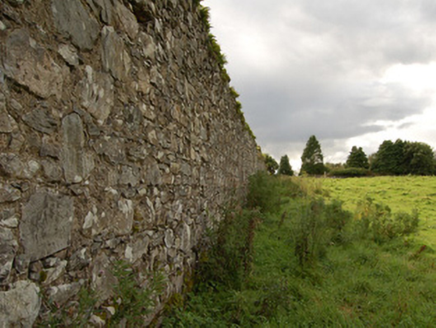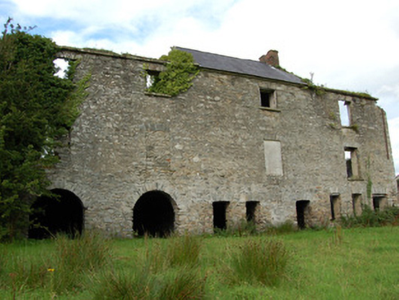Survey Data
Reg No
40838047
Rating
Regional
Categories of Special Interest
Architectural, Historical
Original Use
Coach house
Date
1750 - 1800
Coordinates
213556, 394799
Date Recorded
03/08/2012
Date Updated
--/--/--
Description
Remains of detached multiple-bay three-storey former outbuilding and coach house associated with Drumboe Castle (now demolished, 1945), built c. 1770. Two-storey elevation to the north. Now out of use and derelict. Remains of pitched natural slate roof having projecting cut stone eaves course, and red brick chimneystack. Remains of cast-iron rainwater goods. Rubble stone walls with remains of roughcast lime render over; flush quoins to the corners. Square-headed window openings, some now infilled with rubble stone masonry, having roughly dressed voussoirs and cut stone sills; fittings now gone. Square-headed doorways with roughly dressed voussoirs and with stone plinth blocks to some openings; fittings now gone. Round-headed integral carriage-arches having rubble stone voussoirs over. Located to the west of the site of Drumboe Castle overlooking River Finn to the south, and to the north-west of the centre of Ballybofey. Former walled garden (on rectangular-plan) adjacent to the north having tall rubble stone boundary walls. Remains of other rubble stone structures to site.
Appraisal
This substantial rubble stone former outbuilding is the main surviving element of Drumboe Castle, now demolished. Although now derelict, it is robustly-constructed in rubble stone masonry and its scale provides an insight into the size and wealth of the Drumboe Castle estate during its heyday. The walled garden adjacent to the north survives relatively intact, and its high rubble stone walls enclose a large area that provides an interesting historic insight into the extensive resources required to run and maintain a large country estate in Ireland during the eighteenth and nineteenth centuries. Drumboe Castle was a fine late-eighteenth century county house consisting of a three-bay three-storey central block with a full-height canted projection to the centre, and having two-bay two-storey wings attached to the side elevations having bowed ends. It was probably built c. 1770 – 80, and replaced an earlier castle or house on or close to the same site that was originally built by Sir Ralph Bingley c. 1620. Bingley’s widow, Lady Jane, and a Robert Harrington (Lady Bingley remarried in 1630) took charge of the estate after his death c. 1626 until 1641, when it was granted to Sir William Bazil or Basil (died 1693), Attorney-General for Ireland. It remained in the Basil family until the second half of the eighteenth century (after c. 1777 as still in Basil family ownership in 1777 – Taylor and Skinner Road Maps) when it was acquired, through marriage, by Sir Samuel Hayes (1737 – 1807), later 1st Baronet and Member of Parliament for Augher in the Irish House of Commons between 1783 and 1790. It is probable that Sir Samuel was responsible for the construction of the new house at Drumboe Castle. It was the home of the Hayes Baronets, of Drumboe Castle from 1789 to 1912, when the title became extinct following the death of the 5th Baronet. The Hayes estate(s) in Donegal totalled some 22,825 acres in 1876, making it one of the largest in the county at this time. Drumboe Castle was used as a makeshift prison for a period following seizure by Free State forces during the Irish Civil War. Four anti-Treaty republicans\IRA volunteers (Commandant General Charles Daly, Brigadier Commandant Sean Larkin, Lieutenant Daniel Enright, and Lieutenant Timothy O’Sullivan), later known as the ‘Drumboe Martyrs’, were imprisoned at Drumboe Castle in 1922, tried and sentenced to death in January 1923, and subsequently executed by firing squad here on the 14th of March 1923. They are commemorated by a Celtic High Cross-type memorial (see 40838001) a short distance to the north of the remains of this outbuilding. This building now acts as an historical reminder of Drumboe Castle, the Basil and Hayes families, and also as a reminder of the execution of the four Anti-Treaty volunteers in more recent times, and is an interesting element of the social history of the Ballybofey and Stranorlar areas.



